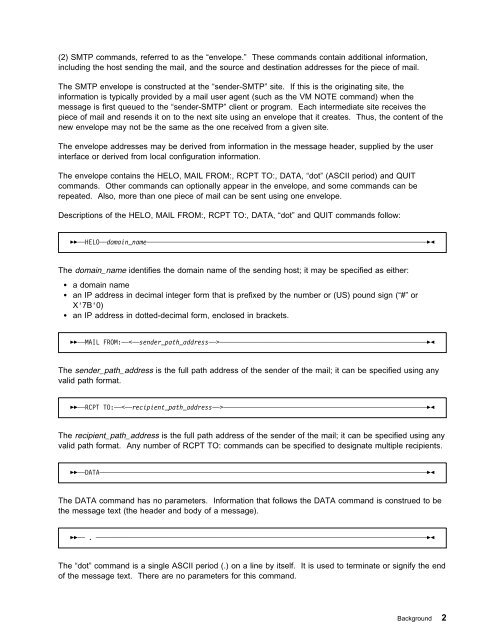TCP/IP SMTP User Exits Support APAR PQ14324 VM TCP/IP ... - IBM
TCP/IP SMTP User Exits Support APAR PQ14324 VM TCP/IP ... - IBM
TCP/IP SMTP User Exits Support APAR PQ14324 VM TCP/IP ... - IBM
You also want an ePaper? Increase the reach of your titles
YUMPU automatically turns print PDFs into web optimized ePapers that Google loves.
(2) <strong>SMTP</strong> commands, referred to as the “envelope.” These commands contain additional information,including the host sending the mail, and the source and destination addresses for the piece of mail.The <strong>SMTP</strong> envelope is constructed at the “sender-<strong>SMTP</strong>” site. If this is the originating site, theinformation is typically provided by a mail user agent (such as the <strong>VM</strong> NOTE command) when themessage is first queued to the “sender-<strong>SMTP</strong>” client or program. Each intermediate site receives thepiece of mail and resends it on to the next site using an envelope that it creates. Thus, the content of thenew envelope may not be the same as the one received from a given site.The envelope addresses may be derived from information in the message header, supplied by the userinterface or derived from local configuration information.The envelope contains the HELO, MAIL FROM:, RCPT TO:, DATA, “dot” (ASCII period) and QUITcommands. Other commands can optionally appear in the envelope, and some commands can berepeated. Also, more than one piece of mail can be sent using one envelope.Descriptions of the HELO, MAIL FROM:, RCPT TO:, DATA, “dot” and QUIT commands follow:►►──HELO──domain_name─────────────────────────────────────────────────────────────────────────────►◄The domain_name identifies the domain name of the sending host; it may be specified as either: a domain name an <strong>IP</strong> address in decimal integer form that is prefixed by the number or (US) pound sign (“#” orX'7B'0) an <strong>IP</strong> address in dotted-decimal form, enclosed in brackets.►►──MAIL FROM:───────────────────────────────────────────────────────────►◄The sender_path_address is the full path address of the sender of the mail; it can be specified using anyvalid path format.►►──RCPT TO:──────────────────────────────────────────────────────────►◄The recipient_path_address is the full path address of the sender of the mail; it can be specified using anyvalid path format. Any number of RCPT TO: commands can be specified to designate multiple recipients.►►──DATA──────────────────────────────────────────────────────────────────────────────────────────►◄The DATA command has no parameters. Information that follows the DATA command is construed to bethe message text (the header and body of a message).►►── . ───────────────────────────────────────────────────────────────────────────────────────────►◄The “dot” command is a single ASCII period (.) on a line by itself. It is used to terminate or signify the endof the message text. There are no parameters for this command.Background 2

















